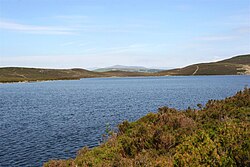Llyn Conwy
| Llyn Conwy | |
|---|---|
 |
|
| Location | Conwy, north Wales |
| Coordinates | 52°59′56″N 3°49′08″W / 52.999°N 3.819°WCoordinates: 52°59′56″N 3°49′08″W / 52.999°N 3.819°W |
| Lake type | natural lake, reservoir |
| Primary inflows | unnamed streams |
| Primary outflows | River Conwy |
| Basin countries | United Kingdom |
| Max. depth | 16 ft (4.9 m) |
| Surface elevation | 1,488 ft (454 m) |
| Frozen | sometimes in winter |
| Islands | 2 |
Llyn Conwy (SH780462) is a lake in the county of Conwy in central north Wales. It is the source of the River Conwy which, on flowing south out of the lake, swings round to then generally flow in a northerly direction for a distance of some 27 miles (43 km) to its discharge in Conwy Bay. Llyn Conwy lies at a height of about 1,488 ft, with a maximum depth of 16 feet, and is by far the biggest lake of the Migneint moors, an extensive area of blanket mire with high rainfall - about 260 cm p.a.
This is an area of Ordovician rocks, lending its name to the "Llyn Conwy Formation", which is identified by its yellowish rhyolitic tuffs. This Formation also reappears in Afon Tryweryn to the south-east, where the hard rock was utilized in the construction of Llyn Celyn dam.
Llyn Conwy is owned by the National Trust and, whilst a natural lake, is managed as a reservoir by Welsh Water.
It supplies some of the water needs of the upper Conwy Valley, including Betws-y-coed and Llanrwst. Contingency plans for drought also name Llyn Conwy as the secondary source in the zone which, along with its own supply area, can feed part of the ‘normal’ Llyn Cowlyd (near Trefriw) supply area. A compensation discharge of 0.91 Ml/d would be required from Llyn Conwy.
The pH level of the lake is reported as pH 7.5257 on average, with calcium carbonate rates at 53.7 mg/l, hardness 3 °GH, free chlorine at 0.2853 mg/l and total chlorine at 0.354 mg/l.
In 2008 the National Trust reported that it was working with its tenant farmers to improve water storage in the Welsh uplands. In this area staff are starting to restore the Migneint blanket bog. Drainage ditches are being blocked to help retain water, to reduce erosion, and to cut the amount of peat entering water courses. Work on the wider Ysbyty Estate aims to improve the quality of drinking water from the lake without the need for expensive treatment works, and to retain the Migneint as one of the largest carbon stores in Wales. Peatland restoration can help enhance wildlife habitats and restore species diversity.
...
Wikipedia
